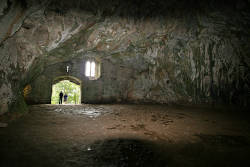Wogan Cavern
Wogan’s Cave - Pembroke Castle - Wogan Watergate
Useful Information

| Location: |
Pembroke, inside Pembroke Castle.
South west Wales, 40 km south of Fishguard, 120 km west of Swansea. From Swanea follow A498 north to Carmarthen, then A40 west towards Haverfordwest. Turnoff onto A477 at St. Clears. (51.677388, -4.920495) |
| Open: |
MAR to APR daily 10-17, last entry 16. MAY to AUG daily 9:30-17, last entry 16. SEP to OCT daily 10-17, last entry 16. NOV to FEB daily 10-16, last entry 15:15. [2021] |
| Fee: |
Adults GBP 7, Children (3-15) GBP 6, Children (0-2) free, Disabled GBP 6, Seniors (65+) GBP 6. Groups (20+): Adults GBP 6.50, Children (3-15) GBP 5.50, Disabled GBP 5.50, Seniors (65+) GBP 5.50. Guide (-25) GBP 35. [2021] |
| Classification: |
 Karst Cave Karst Cave
|
| Light: |
 Electric Light Electric Light
|
| Dimension: | L=25 m, A=7 m asl. |
| Guided tours: | self guided |
| Photography: | allowed |
| Accessibility: | no |
| Bibliography: | |
| Address: |
Pembroke Castle, Pembrokeshire Castle Trust, Pembroke, SA71 4LA, Tel: +44-1646-681510.
E-mail: Ticket office, Tel: +44-1646-684585. |
| As far as we know this information was accurate when it was published (see years in brackets), but may have changed since then. Please check rates and details directly with the companies in question if you need more recent info. |
|
History
| 1093 | Pembroke Castle founded by Roger of Montgomery, inner bailey erected. |
| 1189 | in the hands of William Marshall who built the stone fortress we see today. |
| 1215 | castle passed into the hands of William de Valence, a half-brother of Henry III. |
| 1400 | siege by Owain Glyndwr, Welsh soldier, patriot and hero, bought off by the Constable Francis а Court. |
| 1880s | leased by the antiquarian J. R. Cobb and partly restored. |
| 1928 | bought the local landowner Major-General Sir Ivor Philipps. |
| 1969 | put into a Private Charitable Trust by Mrs Basil Ramsden, the daughter of Sir Ivor Philipps. |
Description

Pembroke Castle was founded by Roger of Montgomery in 1093. At this time it was an earth and timber construction, but still it resisted all counter-attacks by Welsh forces. In 1189 William Marshall transformed it into the enormous stone fortress that we can still see today. But according to legend an Irish bishop had put a curse on William Marshall, all his sons would die childless. The line ended and the castle passed into the hands of William de Valence, a half-brother of Henry III. He became Lord of Pembroke through his marriage to Joan, granddaughter of William Marshal. After the death of Aymer de Valence, Pembroke Castle reverted to Richard II. It was granted out in a series of short tenancies and as a result began to fall into disrepair. Owain Glyndwr, Welsh soldier, patriot and hero, led yet another rebellion against the hated English settlers in 1400. The Constable Francis а Court bought off a siege by paying danegeld.
Finally the castle was not used anymore. It was owned by the Pryse family from Gogerddan. It was plundered for stone by the locals and the ruin became a subject of many Romantic paintings. Finally, in the 1880s it was leased by the antiquarian J. R. Cobb. He restored a part of the castle. In 1928 the castle was bought the local landowner Major-General Sir Ivor Philipps. He finally restored the castle to its former glory, which was completed at the outbreak of World War II. His daughter, Mrs Basil Ramsden, finally put into a Private Charitable Trust in 1969.
The most unusual feature of the castle is Wogan Cavern, a huge natural cave, beneath the north-eastern corner of the castle at sea level. It is accessible via 55 steps from inside the castle. The huge cavern was closed by a massive wall and provided a good storage space. Possibly it has also been used as a boathouse.
Wogan Cavern is a natural limestone cave, a karst cave, but it was heavily altered to fulfil the demands of the Medieval castle. Still many parts of the cave remained untouched, like the cave sediments, in which flint tools from the Paleolithic and Mesolithic have been found. It was also used during the Roman occupation of Britain, a Roman coin hoard was found. The were no remains from the Bronze Age, but this probably just means they were destroyed. In the Middle Ages it became an essential part of the castle, which was strategically placed on the Milford Haven waterway. The cave could easily be accessed by a boat to the mouth, so it was probably used as a boat house. Originally outside the castle’s defences, it was incorporated during the 13th century with a large watergate being built across the mouth of the cavern. That’s why it is also called the Wogan Watergate.
- See also
 Wogan Cavern by Tony Oldham (1972).
Wogan Cavern by Tony Oldham (1972). Search DuckDuckGo for "Wogan Cavern"
Search DuckDuckGo for "Wogan Cavern" Google Earth Placemark
Google Earth Placemark Wogan’s Cavern (visited: 08-JUL-2021)
Wogan’s Cavern (visited: 08-JUL-2021) Wogan Cavern - Atlas Obscura (visited: 08-JUL-2021)
Wogan Cavern - Atlas Obscura (visited: 08-JUL-2021) Wogan Watergate (visited: 08-JUL-2021)
Wogan Watergate (visited: 08-JUL-2021) Pembroke Castle, an extensive description of the castle at the Castles of Wales web site. Includes some words and a picture on the cave.
Pembroke Castle, an extensive description of the castle at the Castles of Wales web site. Includes some words and a picture on the cave.
 Index
Index Topics
Topics Hierarchical
Hierarchical Countries
Countries Maps
Maps